How To Use Low Competition Keywords To Rank Higher On Google

By Prebuilt Sites Team
November 29, 2021
EDITOR’S NOTE: One factor that you want to look at when choosing keywords is competition. While higher competition keywords get more traffic, it’s more difficult to rank in those spots especially if you’re a newer site. Targeting low competition keywords, or keywords that you can rank for with little effort, will allow you to get traffic to your site even if you have a lower website authority. To find low competition keywords we recommend using a keyword tool (such as Ahrefs) to search for keywords that have a lower difficulty score. Once you’ve found a list of keywords, there are a few other factors you need to look at to make sure you’re creating the content that people searching for these keywords are looking for: search intent, website authority, and high quality backlinks. Looking at all of these factors will ensure that the keywords you’re ranking for are truly low competition. If all of this sounds overwhelming or you’d like a more in depth SEO strategy, reach out to us at The BBS Agency and we’d be happy to help!
Does that mean you shouldn’t target competitive keywords?
No. But it does mean you should pursue lower-competition keywords in the short term.
In this post you’ll learn how to find low-hanging keyword opportunities in a few simple steps, and how to make sure those keywords are truly low-competition and easy to rank for.
Low-competition keywords are keywords that you can rank for without much effort. You usually won’t have to build many links or have high website authority (Domain Rating) to rank for them and get organic traffic to your website.
Follow these three steps to find thousands of high-volume, “low-competition” keywords fast.
Video: Ahrefs
1. Brainstorm topics
Think about what your target audience might be searching for in Google and jot down your ideas. You don’t need to try to guess exact phrases here; just note down broad themes.
For example, if you sell computers and parts online, these might be:
- computer
- laptop
- macbook
- imac
- hard drive
Don’t overthink this. Just write down what comes to mind.
Move on to step two once you have 5–10 ideas.
2. Expand ideas with a keyword research tool
Plug your topic ideas into a keyword research tool like Ahrefs’ Keywords Explorer, then go to the Phrase match report. You’ll see keyword ideas including one or more of the words and phrases you entered, complete with monthly search volumes and other SEO metrics.

Photo: Ahrefs
3. Filter for low ‘difficulty’ keywords
Many keyword research tools have a difficulty score. Ours is called Keyword Difficulty (KD) and it’s a numerical representation of how hard it’ll be to rank in Google’s top 10 for a search query.
In the Phrase match report, filter for keywords with a KD score between 0–10 to find “low-competition” keywords.

Photo: Ahrefs
You can see above that we managed to find over 167,000 keywords from just five “seed” topics. If you want to narrow down the list, just add a minimum monthly search volume filter.
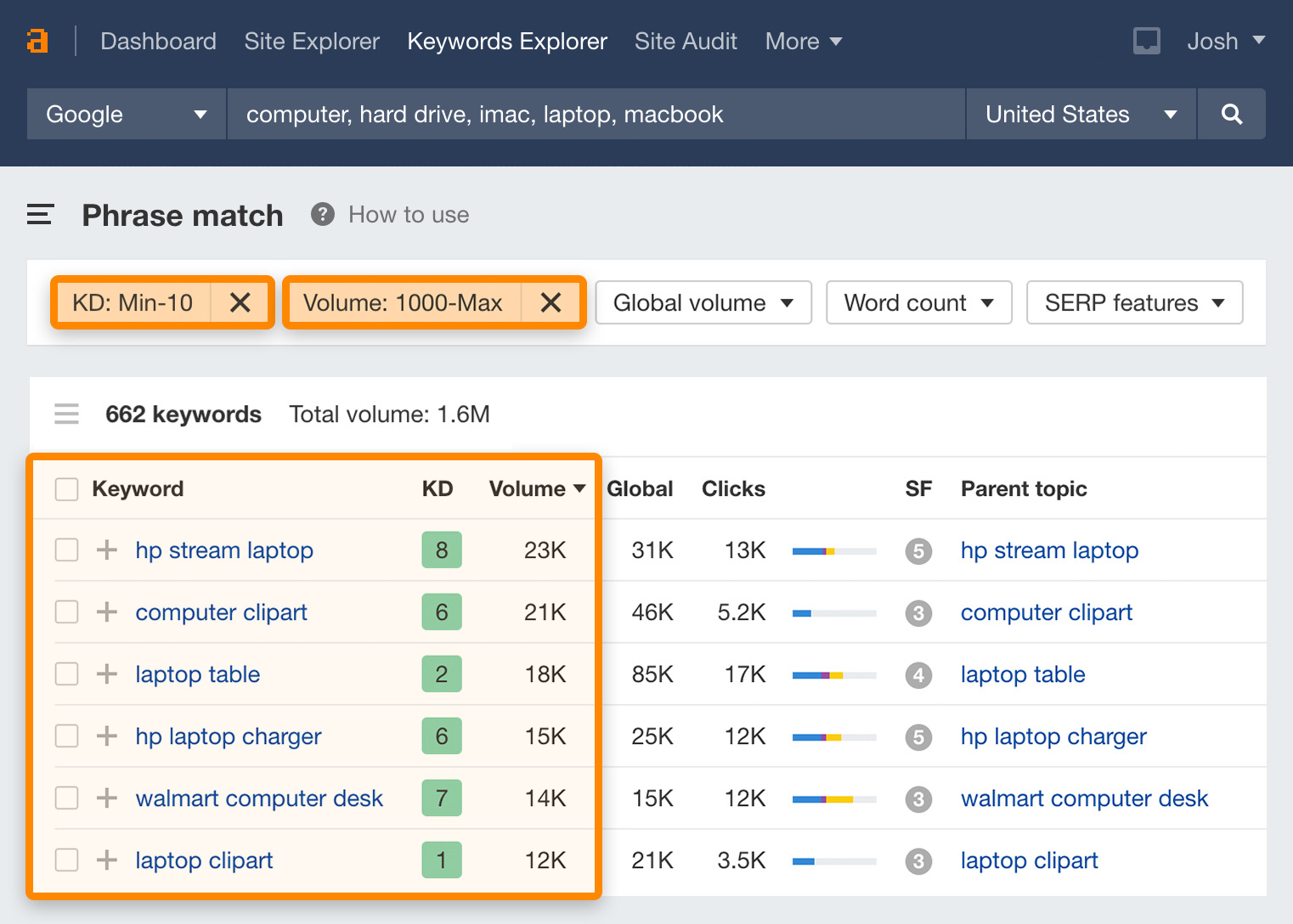
Photo: Ahrefs
Yes and no.
Google uses hundreds of ranking signals, so it’s simply not possible for any third-party SEO tool to decrypt them all and compute an “accurate” keyword difficulty metric. It’s unrealistic and borderline impossible, especially when you consider that many of these “ranking factors” are mere speculation and have never been confirmed by Google.
It’s also important to understand that each SEO tool uses a unique formula for their keyword difficulty score, which is why scores are often vastly different from tool to tool:

Photo: Ahrefs
At Ahrefs, our Keyword Difficulty score calculation is simple: we take a weighted average of the number of referring domains (linking websites) pointing at the top 10 pages. That means the top-ranking pages for high KD keywords have many backlinks, and the top-ranking pages for low-KD keywords have few backlinks.
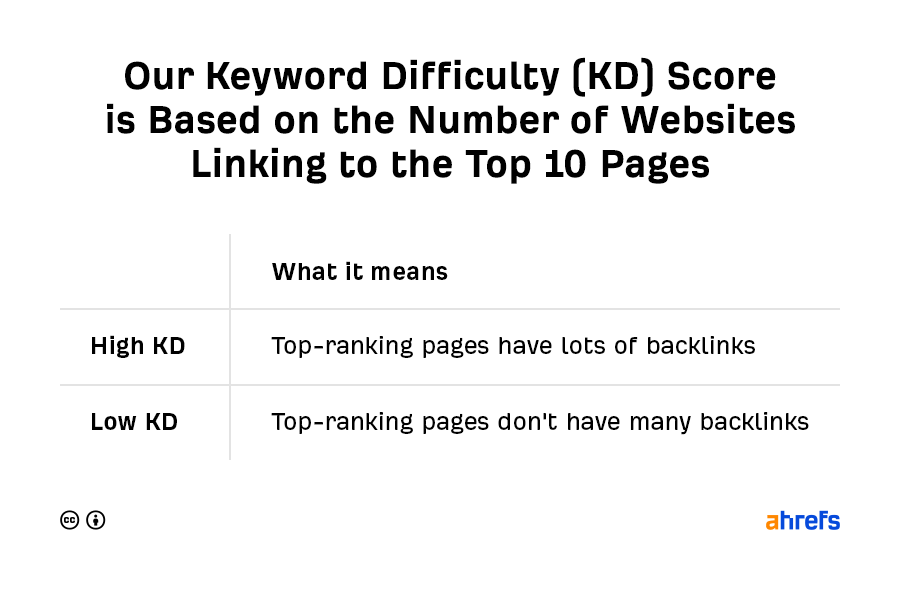
Photo: Ahrefs
If you’re using a keyword research tool other than Ahrefs, hit up their support and ask how they calculate their keyword difficulty score. You can’t really use it effectively unless you know how it works.
Given that backlinks are arguably the most important ranking factor, our Keyword Difficulty score is usually a decent proxy for ranking difficulty. If a keyword has a low KD score in Ahrefs, it’s “low-competition” in the sense that you probably won’t have to build or earn many backlinks to compete.
But you shouldn’t judge competition solely on this metric. There are other factors you need to consider before targeting a keyword.
Let’s walk through three of the most important ones.
Search intent
Even if a keyword is super low-difficulty, you’ll struggle to rank for it without creating the kind of content that searchers are looking for. So when doing keyword research, it’s worth looking for keywords that actually make sense for the type of content you want to create.
The four broad types of keywords are:
- Informational. The searcher is looking for information about a topic.
- Navigational. The searcher is looking for a specific website.
- Commercial investigation. The searcher wants to buy a particular product or service, but hasn’t quite made up their mind which one to buy.
- Transactional. The searcher is looking to buy something.
You can often tell which bucket your keyword falls into by looking for keyword modifiers in the query. If it contains words like “buy” or “cheap,” it’s most likely a transactional query. If it contains words like “how,” “what,” or “where,” then it’s probably informational.
Here’s a quick keyword modifier cheat sheet:
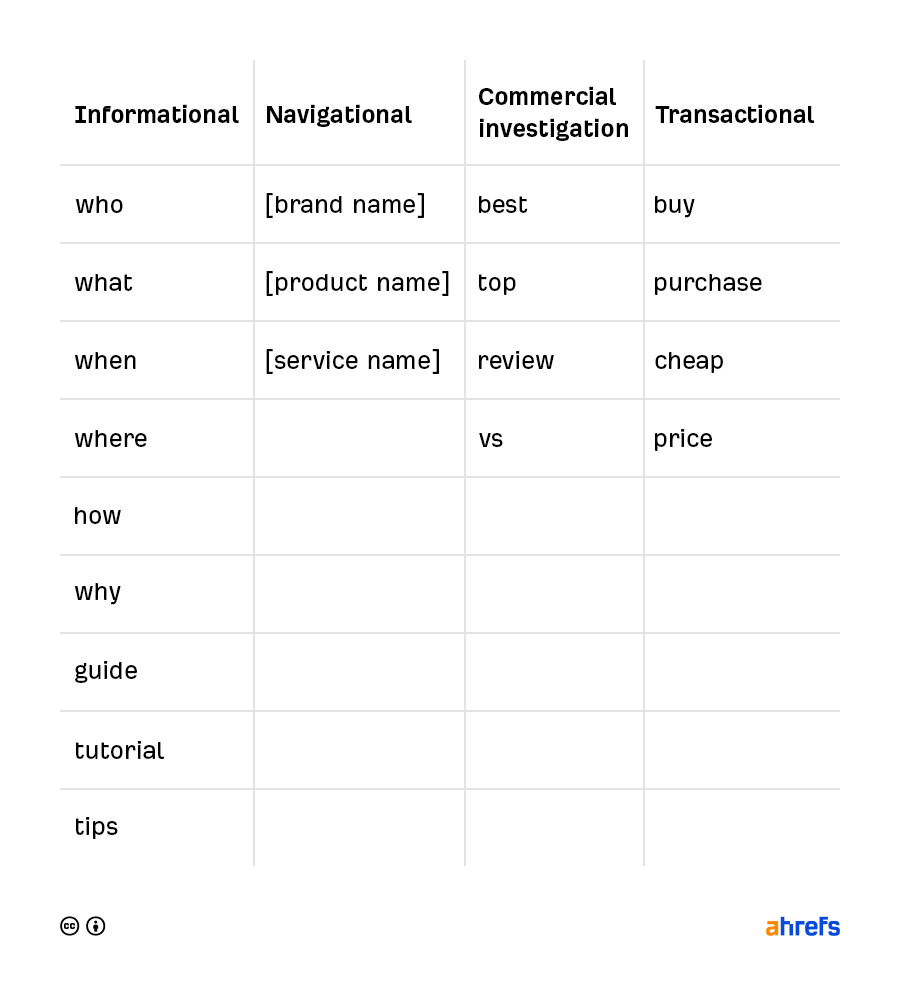
Photo: Ahrefs
In Ahrefs’ Keywords Explorer, you can find keyword ideas that fall into any of these buckets using the “Include” filter.
For example, if you were looking for low-competition transactional keywords, here’s how you’d do it:
- Enter your seed keywords
- Choose the “Phrase match” keyword ideas report
- Filter for low-competition keywords with the KD filter (KD < 10)
- Add words like “buy” and “cheap” to the “Include” filter
- Toggle the “Any word” switch
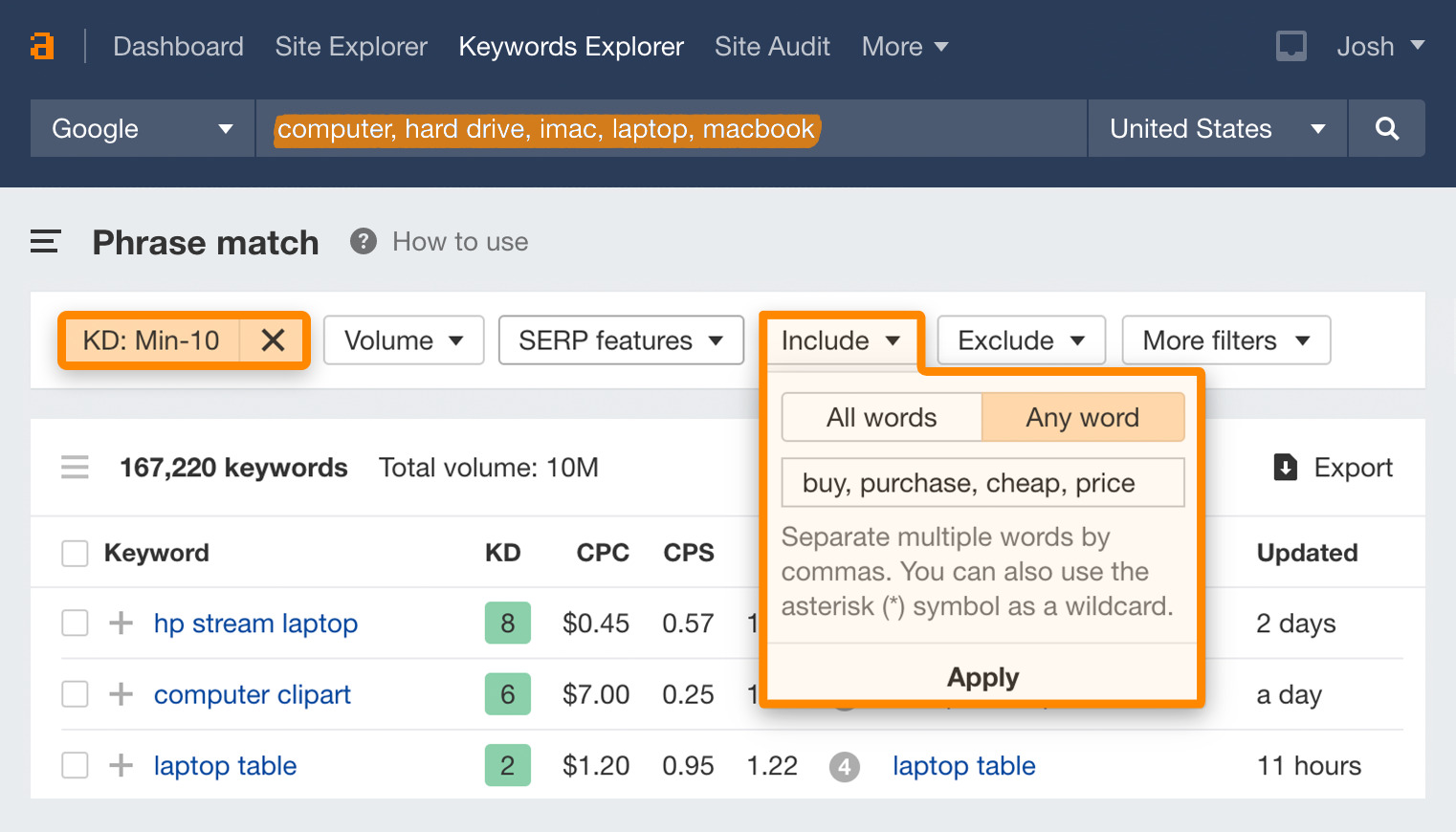
Photo: Ahrefs
If you were looking for low-competition informational keywords for a blog, you can do the same thing with informational modifiers. But an even quicker method is to use the Questions report, which shows keyword ideas phrased as questions.
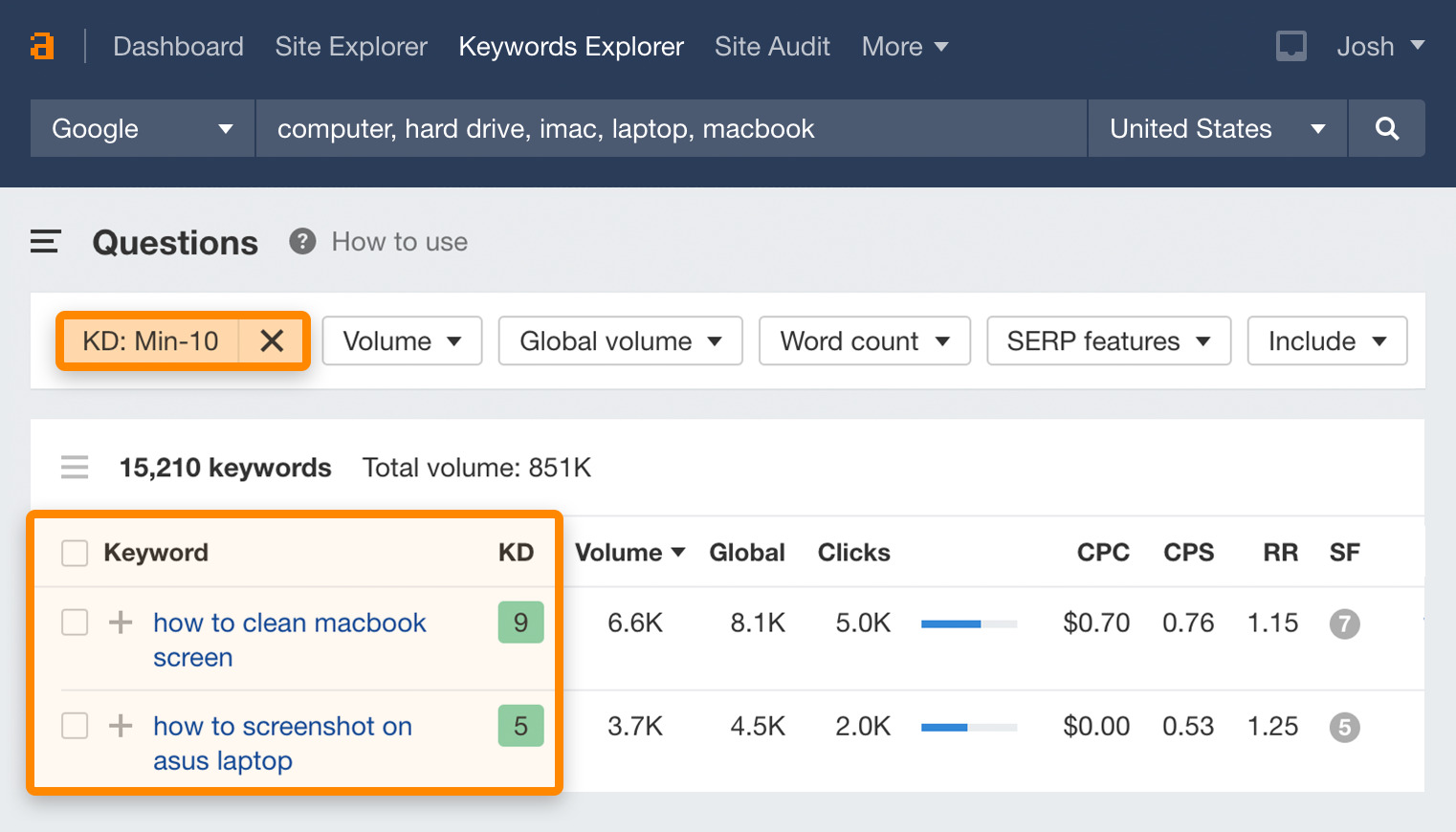
Photo: Ahrefs
Just know that while filtering for keyword modifiers works, it’s far from foolproof because keywords with modifiers won’t always align with the expected type of search.
Think about a keyword like “best buy coffee makers.”
Despite containing the transactional “buy” modifier, it’s not a transactional keyword. It’s navigational because people are looking for results from Best Buy—a popular North American electronics store.
This further highlights how search intent can affect keyword competition. Although this query has a Keyword Difficulty score of 1, it’s not low-competition because it’s a navigational keyword. You’re never going to outrank Best Buy, no matter what you do—because they rank in all 10 positions on the first page of Google.

Photo: Ahrefs
Website authority
Domain Rating (DR) measures a website’s authority on a scale from zero to one hundred based on its backlink profile.
Many SEO professionals believe that Google uses some kind of website authority metric in their ranking algorithm, but Google’s John Mueller has publicly stated that this isn’t true on numerous occasions.
Either way, you’ll notice that for some seemingly low-competition keywords with low KD scores, all of the top-ranking pages come from very high DR websites.
Case in point, “black sandals”:

Photo: Ahrefs
Despite having a Keyword Difficulty score of just 1, the average Domain Rating for the first page of results is 86 and the lowest DR we see is 76.
Does this prove that website authority is a ranking factor?
Not necessarily. It’s arguable that this is more about brand equity than website authority. Big brands likely dominate the SERP because that’s where most people want to shop.
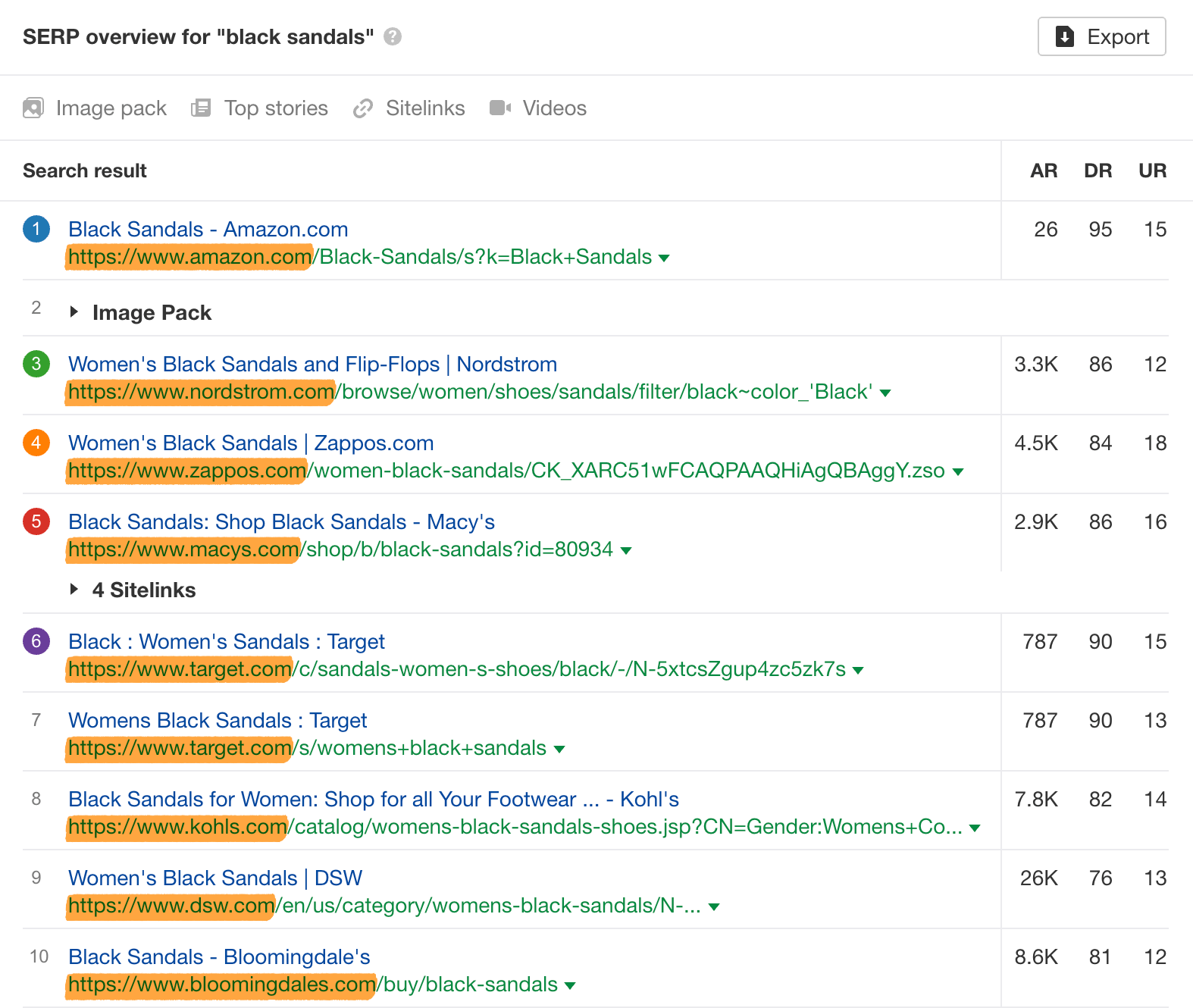
Photo: Ahrefs
Unfortunately, you can’t do much about this if you have a “weaker” website and brand. You’ll probably struggle to rank for keywords where brand equity seems to play a role.
Which brings us on to an important point:
Ranking difficulty is relative.
If you’re Target, “black sandals” is a low-competition keyword because you have the authority and brand equity to rank. If you’re a small mom and pop shoe store, “black sandals” is a high-competition keyword because you’re not on the same playing field as the big brands that dominate the SERP.
Does that mean it’s impossible for less authoritative and well-known brands to outrank the big guns? No. It’ll just be harder, so it’s something to keep in mind when looking for low-competition keywords.
High-quality backlinks
Keyword Difficulty takes the quantity of backlinks pointing at the top-ranking pages into account, but not their quality. You’d need to consider many things to assess the quality of a link, including:
- Relevance of the linking website and page
- Authority of the linking website and page
- Link placement on the page
- Anchor text of the link
- Follow vs. nofollow status

Photo: Ahrefs
It’s near-impossible to take all of these things and more into account when crafting a keyword difficulty score, so we keep things simple and consistent by looking solely at the average number of referring domains (linking websites) pointing at the top 10 pages.
For that reason, it’s always worth manually checking the backlink profiles of the top-ranking pages because quantity isn’t everything.
To illustrate, let’s take a look at the number of referring domains to the top-ranking pages for two keywords with equally low KD scores:

Photo: Ahrefs
At first glance, it seems easier to rank for the second keyword because the page you’re competing with has fewer links. But what really matters is the quality of the links.
For the page with 14 RDs, 94% of the backlinks are followed, with most coming from relevant and authoritative pages and websites. They also have mostly relevant anchors.
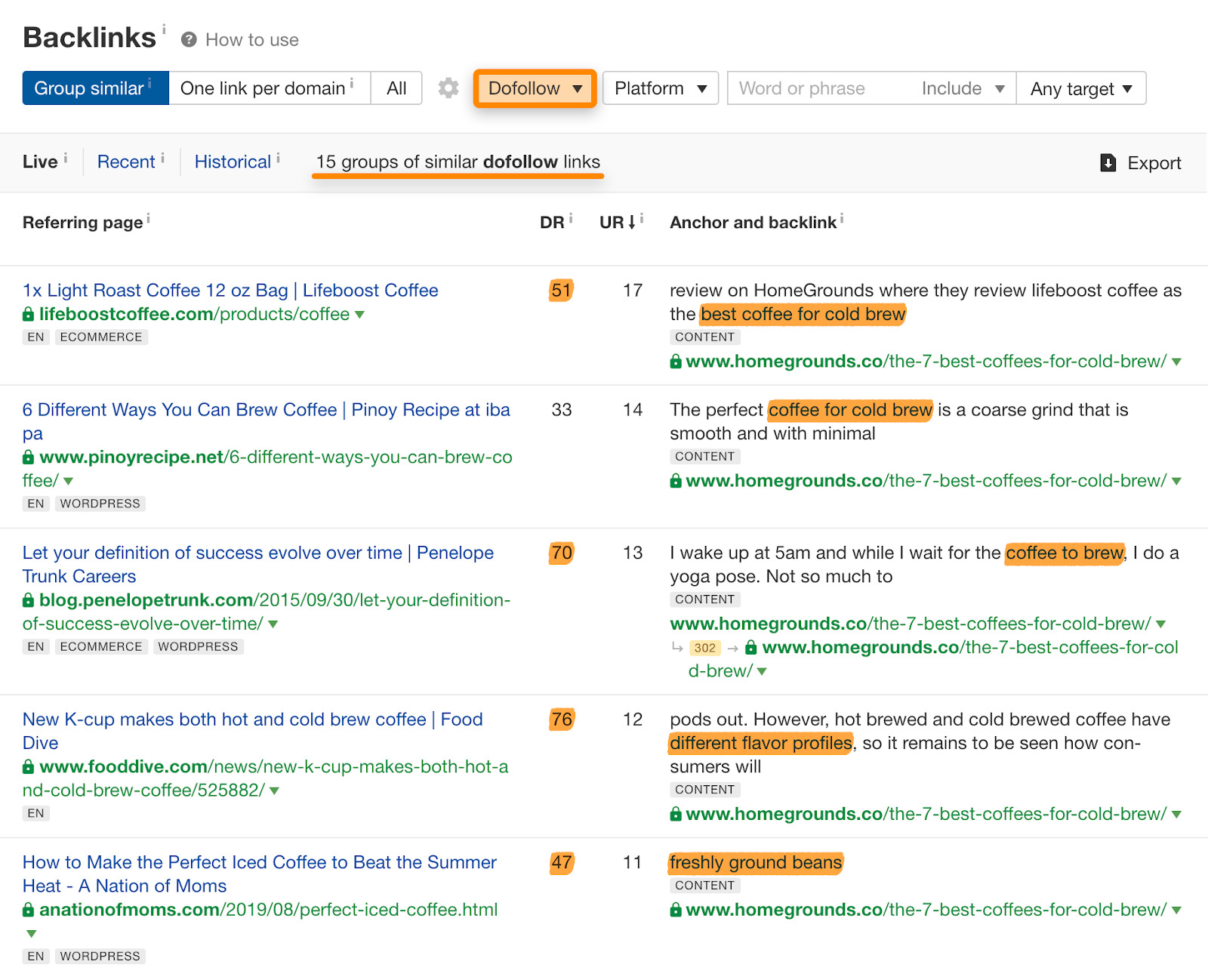
Photo: Ahrefs
For the page with 92 RDs, 96% of the backlinks are nofollowed, with most coming from pages on low-authority coupon code sites. They also have mostly naked URL anchors.

Photo: Ahrefs
Nofollow hints to Google that links shouldn’t influence rankings, but they may choose to ignore that hint. Learn more here.
In fact, there are arguably only two “okay” backlinks pointing at the page with 92 RDs. Whereas the majority of the links pointing to the page with just 14 RDs are relevant and high-quality.
In conclusion, all else being equal, it would probably be easier to outrank the page with 92 RDs than the page with 14 RDs. So despite having the same KD scores, “best coffee for cold brew” is arguably a less competitive keyword than “best fly fishing combo for beginners.”
Many people stick to low-competition keywords because they don’t think they can rank for anything else. Even if that’s true in the short term, high-competition keywords can be opportunities for different reasons.
Remember, Ahrefs’ Keyword Difficulty score is based on backlinks. This means that, on average, the top-ranking pages for high KD keywords have lots of backlinks.
In other words, high-competition keywords are often great topics for link bait—content that’s specifically formulated to attract links.
To find these topics, do the opposite to what you did before. Instead of filtering for keywords with low KD scores, filter for keywords with high KD scores.
For example, if you have a site about resumes, you would:
- Head to Keywords Explorer
- Enter a relevant ‘seed’ keyword (e.g., “resume”)
- Go to the Questions report
- Filter for keywords with high KD scores (e.g., 50+)

Photo: Ahrefs
If you check the SERP overview for any of these keywords, you should find that many of the top-ranking pages have lots of backlinks.

Photo: Ahrefs
In this case, if you created the best guide to writing a resume on the web, the people linking to these existing pages would make great link prospects. You just need to reach out with a compelling reason for them to link to you.
Get enough high-quality backlinks to your page and chances are you may be able to rank—even if you’re lacking authority and brand equity.
Either way, there are two other benefits to targeting high-competition keywords (even if you don’t rank):
- You can increase website authority. Brand equity and authority don’t appear out of thin air. They’re primarily a byproduct of links.
- You can pass that ‘authority’ to important pages. Use internal links from high-authority “linkbait” to boost relevant pages targeting lower-competition keywords.
That second benefit is what we like to call The Middleman Technique.

Photo: Ahrefs
It’s a smart way to boost the ‘authority’ of boring pages that are difficult to get links to.
Recommended reading: A Simple SEO Strategy (The ‘Middleman’ Method)
Final thoughts
Keyword competition is relative. Because no keyword difficulty score takes everything that affects competition into account, you should always manually review the top-ranking pages before creating content.
Fail to do this and you may end up pursuing keywords that aren’t truly low-competition. While there’s nothing wrong with that, such keywords should be medium or long-term targets, not short-term targets.
Got questions? Ping me on Twitter.
Originally posted on Ahrefs.

